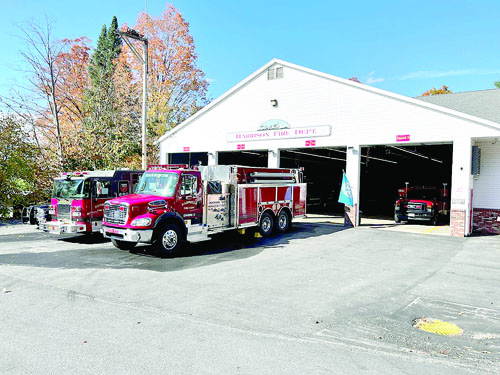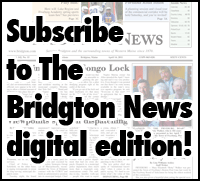Harrison hires firm to study Fire Department needs

By Wayne E. Rivet
Staff Writer
HARRISON — When taxpayers turned down for the second time a proposal to hire a full-time fire chief or add EMT/firefighters to provide greater coverage, they sent town officials a clear message.
We want an independent study as to the needs of the town.
Two consultants last Thursday pitched to the Select Board how they would analyze the Harrison Fire Department and ultimately develop a recommended plan of action.
Via Zoom, John Bellino of Kennebec Consulting and David Houghton of Municipal Resources Inc. (MRI) gave presentations and answered questions posed by the Select Board.
Later in the evening, the Select Board entered executive sessions to discuss the two proposals, and ultimately awarded the contract to MRI, not to exceed $17,500. The study will be funded by ARPA money — federal dollars received as part of the American Rescue Plan Act of 2021, which was a $1.9 trillion dollar stimulus package passed during the Covid-19 pandemic.
ARPA funds will be used because no money was set aside in the present budget for a fire study.
John Bellino of Kennebec Consulting was up first. He has been involved in fire service for 30 years, including working for a department similar to the size of Harrison for the last 11 years.
“I served as a chief officer on that department and had the opportunity to do a similar-type of study when I took over as chief. The great part was not only being able to do the evaluation, but to implement some of those things, as well,” he said.
Bellino was the town manager of Clinton, served as fire chief in Richmond, has taught paramedic training courses in Brunswick, and has been a paramedic for 25 years.
He felt well suited to take on the study because of his familiarity with communities the size of Harrison and what those fire departments have in terms of equipment and leadership.
“I’ve spent a lot of time studying different systems. I have a diverse background in how different things are done. One of the things that is difficult in a lot of smaller towns is that things have typically been done a certain way for a very long time,” he said. “I feel I have the background having experienced different types of departments that I’m able to shed a little bit of light on other ways that something could be done.”
When asked what “process” he would use in this study, Bellino said he would want to speak to those in command staff positions, fire department members (“I’d be interested in how things are going with the department and/or where they see things going,” Bellino noted), town staff and elected officials, as well as some members of the public.
When asked how many studies he has done, Bellino said he completed three cardiac arrest survival studies for three different communities and two fire department feasibility studies.
Select Board member Collen Densmore asked if there are benchmarks and industry standards Bellino will use to measure Harrison compared to other similar communities.
Bellino uses standards of the National Fire Protection Association, the National Volunteer Fire Association, Department of Labor, Maine EMS and others.
“I think it is appropriate to compare your community to other similar-sized towns that have similar infrastructure. I understand communities to communities are not always necessarily apples to apples, but sometimes you can get sort of close,” he said.
When he was asked about whether he was familiar with Cumberland County studying the potential for collaborative services, Bellino said he was.
“I’m a proponent of regionalization if it can work...I think that there’s a lot of interest and positive ideas in that area if that was a direction that the town were looking to go,” said Bellino, who as town manager worked with a neighboring town to share a transfer station. “I would be presenting you options, suggestions and ideas.”
Bellino closed his presentation saying, “My understanding of a community doing something like this would be wanting to know a direction to go in the future. You know, vehicle replacement plans, how many trucks do you need? That’s sort of a hot topic now here in Maine, is that a lot of small towns feel that they need to have one of everything. One of the things I did when I took over as fire chief, part of my feasibility study looked at, what do we need for equipment? That was one of the things I was able to implement is a reduction in equipment, not an addition in equipment. Because we had more equipment than we needed. I got the size of a fleet down. I think there’s a lot of towns that are starting to realize that for years we’ve been spending thousands or in some cases millions of dollars on all this great equipment. But if you don’t have the human capital to operate a real nice piece of equipment, there’s not really much of a point in everybody having their own fancy forestry vehicle.”
Up next was David Houghton with MRI (Municipal Resources Inc., which has offices in Portsmouth and Plymouth, N.H.
Houghton has 42 years in fire service, who recently retired but works for MRI, which has been in business since 1989.
“The projects that I’ve been doing for them is everything from studies for departments, just like this one is to assessment centers for everything from a fire chief to call firefighters to full-time firefighters. I’m fortunate that we work with a large team of people and people kind of get picked and moved into different areas depending on what their expertise is and where they kind of fit into the scope of a project,” he said. “This is a project very similar to one I’m just about finishing up now — two projects in Maine that are almost twins to what you’re asking for here. So, we’re very versed in what you’re looking for as far as the end results are, but also very familiar with all of the things that John (Bellino) just mentioned, and then some. I think what’s kind of unique from us is that we do have a team of people and we’re able to get work done quicker because everybody kind of has their assigned project or assigned task to do within a project. The one thing that we’ve been very successful for doing is coming in and doing what we call a nominal group session, which we would go through the fire chief and try and get as many of his personnel into the station one night and sit down and have a discussion.”
Then, he would reach out to town folks, “whoever would like to offer anything.” Meetings are done either in person or Zoom.
“We’ve learned that a lot of times in a group setting, you really don’t get the true feeling or the true comments that that people really want to make because they're afraid of retribution or things like that. So, we do an awful lot of Zoom calls with people to kind of get their feelings for it. The one thing that that I know John brought up is the same thing is about looking at apparatus equipment. The one thing that we’re very sensitive about is about cost,” Houghton said. “One of the projects I’m working on in Maine right now, we actually are developing, we’re calling it a roadmap, the steps that they need to take and approximate the funding numbers that they’re going to need to be able to build out their department in a palatable way for the residents. There’s an awful lot of grants that are out there, so we’ll look to see where there are holes in the department that could be grant funded or not. We’re able to give all that information as part of the project. Like I said, I think our biggest thing is that we have a group of people with multiple talents. It’s just not my way because other people that I work with on different teams look at things a little bit differently. All with the same goal is to try to do what’s best for the individual communities when we our final project.”
Houghton said Harrison’s interest in a study comes at a perfect time since he will be wrapping up two projects (Kennebunkport and Fairfield/Benton) next week.
Houghton said his “group” would likely be two or three members. Houghton and MRI have done 16 studies over the last four years, mostly in New England. He noted that most MRI people are active fire service.
“I think that the key to this whole thing is not using people to do studies that are, I’ll say, old school or kind of stuck. You need to be fresh in what’s happening right now. And even as John said, the fire services have really changed, especially since Covid, our availability of responders. Our numbers are dropping like crazy. The cost of our equipment is going through the roof. We just did a project for a community that wanted to buy a ladder truck and we’re trying to justify buying a ladder truck at $1.25 million and we couldn’t help them justify spending that kind of money,” Houghton said. “However, they’re going to do a joint venture with another community and split the cost of it and they’ll share the resource together. I just think having people that are active in the fire service and can kind of appreciate the cost value yet still try to maintain a safe environment for the residents of the community. I think that’s key to being able to do that. We have people that are up to date on what’s happening.”
A firefighter attending the meeting pointed out the goal of the study is, “We’re just trying to get a baseline to improve our services to the town.”

